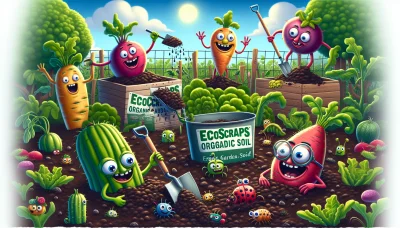English peas Quiz
Test Your Knowledge
Question of
Introduction to English Peas
English peas, also known by their botanical name Pisum sativum, are a variety of green peas often encased in a pod. Unlike their relatives, the snow peas and sugar snap peas, English peas are recognized for their need to be shelled before consumption, as their pods are not edible. These peas are sweet and tender, making them a popular choice for a variety of culinary uses, from fresh salads to hearty soups. They thrive in cooler weather, making them an excellent crop for spring and fall gardens.
The Benefits of Growing English Peas
English peas, often cherished for their sweet flavor and tender texture, bring a multitude of nutritional benefits and environmental advantages to any garden. Nutritionally, they are a powerhouse of vitamins and minerals, including Vitamin C, Vitamin K, and manganese, which are essential for maintaining good health. These peas are also a great source of plant-based protein and fiber, contributing to muscle health and digestive well-being. From an environmental perspective, growing English peas can enrich the soil with nitrogen, reducing the need for chemical fertilizers. Their ability to fix nitrogen naturally improves soil fertility, making them an excellent crop for sustainable agriculture practices. Additionally, as a cool-season crop, English peas can be grown early in the spring or fall, fitting well into crop rotation schedules and helping to prevent soil erosion. Overall, incorporating English peas into your garden not only benefits your health but also contributes to a healthier planet.
Choosing the Right Variety
When it comes to gardening, selecting the right variety of English peas can significantly impact both yield and taste. Varieties such as 'Knight', known for its sweet flavor, are ideal for those who prioritize taste. For gardeners dealing with limited space, 'Tom Thumb', a dwarf variety that doesn't require staking, could be the perfect fit. It's not just about the space or taste; climate adaptability plays a crucial role as well. Varieties like 'Wando' are more tolerant of warmer climates, making them a suitable choice for gardeners in regions with shorter cool seasons. Understanding the growth habits, taste, and climate adaptability of each variety can help ensure a bountiful and delicious harvest.
Planting and Care Instructions
- Soil Preparation: Begin with well-draining soil enriched with compost or well-rotted manure to ensure rich fertility. The soil pH should ideally be between 6.0 and 7.0.
- Planting Depth and Spacing: Plant seeds 1 to 1.5 inches deep, spacing them about 2 inches apart in rows. Rows should be spaced about 18 to 24 inches apart.
- Watering: Keep the soil consistently moist but not waterlogged. Watering is especially crucial when the plants are flowering and developing pods.
- Sunlight Requirements: English peas require full sun, meaning at least 6 hours of direct sunlight per day. However, they prefer cooler temperatures, so in warmer climates, some afternoon shade can be beneficial.
Common Pests and Diseases
English peas are susceptible to a variety of pests and diseases that can hinder their growth and reduce crop yield. Some of the most common issues include aphids, which suck the sap from the plants, powdery mildew, which covers the leaves in a white, powdery coating, and fusarium wilt, a soil-borne fungus that causes plants to yellow and wilt. Fortunately, there are several preventive measures and organic control methods that can help manage these problems.
- Encourage Beneficial Insects: Plant flowers nearby to attract natural predators of pests, such as ladybugs and lacewings.
- Proper Spacing: Ensure peas are planted with adequate space between them to improve air circulation and reduce the risk of fungal diseases.
- Neem Oil: Apply neem oil to the plants, which acts as a natural pesticide and can help control aphids and prevent fungal diseases.
- Remove Infected Plants: Promptly remove and dispose of any plants that are heavily infected to prevent the spread of disease to healthy plants.
- Use Disease-Resistant Varieties: Opt for pea varieties that are resistant to common diseases such as fusarium wilt to reduce the likelihood of disease outbreaks.
Harvesting and Storing English Peas
To ensure the best flavor from your English peas, it's crucial to harvest them at the right time. The peas should be plump, bright green, and should fill the pod well, but not be too crowded. The pods should still have a glossy sheen to them, which indicates they are not overripe. The best time of day to pick English peas is in the morning when they are crispest. Gently pull or snip the pods from the plant, being careful not to damage the plant for future harvests.
- Refrigeration: Store unwashed fresh peas in a plastic bag in the refrigerator. They can last for about 5 to 7 days.
- Freezing: To freeze, blanch the peas for 1-2 minutes, then plunge them into ice water to stop the cooking process. Drain well and freeze in airtight containers or freezer bags.
- Drying: Peas can be dried and stored for extended periods. Shell the peas, spread them out on a drying rack, and place them in a dry, well-ventilated area until completely dried out.
- Canning: Canning is another option for long-term storage. Peas should be shelled, blanched, and then canned using a pressure canner according to safe canning practices.
Delicious Recipes Using English Peas
| Recipe Name | Ingredients | Preparation Time |
|---|---|---|
| Pea Soup | English peas, vegetable broth, onions, garlic, salt, pepper | 45 minutes |
| Peas and Ham Pasta | Pasta, English peas, ham, cream, parmesan cheese, salt, pepper | 30 minutes |
| Minty Pea Salad | English peas, mint, feta cheese, olive oil, lemon juice, salt, pepper | 15 minutes |
| Pea and Potato Curry | Potatoes, English peas, curry powder, coconut milk, onions, tomatoes, cilantro | 1 hour |












